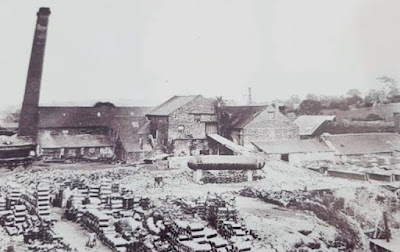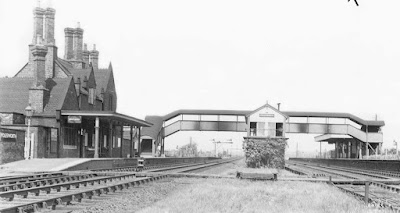History - It's Been Demolished!
Polesworth lies on the Trent Valley line of the West Coast rail route, between Atherstone (bottom right on the map above) and Tamworth (top left). The village is in Warwickshire, but almost on the border with Staffordshire ...... as per the thick black "border" line on the left above. The motorway is the M42 and the green road is the A5. A few miles north of Polesworth and you are in Derbyshire ...... and eastbound roads take you into Leicestershire.All this is because Polesworth is part of a carbuncle excrescence seemingly stuck on to the northern edge of Warwickshire.There was plenty of history in and around the village. On the High Street is the magnificent Abbey Gateway ...... but without an Abbey which after 700 years of doing what Abbeys do, was dissolved peremptorily and its extensive lands handed to one of the in-crowd, Francis Goodere, who used the Abbey stonework to build Polesworth Hall.
Polesworth Hall was demolished in 1870! But the former Abbey grounds are extensive and open to the public ...... as is the later Abbey Church. Pleasant walks are on offer through the grounds and down by the River Anker.
The industrial revolution came to Polesworth in the form of brickworks (demolished) ...... and a colliery, the latter being developed as part of a small "country park".Henry Goodere, son of Francis, was a patron of the arts and Polesworth Hall was a centre of culture during Elizabethan times. The poet Michael Drayton was in the service of the Goodere family around 1580, and his works contain allusions to Polesworth and the River Anker. Other notable figures including the dramatist Ben Jonson, architect Inigo Jones and poet John Donne, made up the core of an elite group who became known as the Polesworth Circle.
So once upon a time, Polesworth was a hip hop happening place!
There was more social change to come.
There were significant goods facilities and the colliery was rail served. Even in its two-track form, there would have been quite a bit of activity at the station.
The houses to the east of Station Road (surely railway premises) still stand ...
The track was widened to four lines between 1901 and 1903.The original plan was to build an island platform for the fast lines, but this never happened.
An old map also shows tracks to the colliery ...... with some photos showing significant rail activity.Pooley Hall (from which the pit takes its name) has its origins in premises constructed in the early 16th century. The much revised building still stands, unlike much if the rest of Polesworth's history ...... and older parts of the building are reckoned to be examples of some of the very first brick construction in the UK.
The present Hall was built in 1509 by Sir Thomas Cockayne "The Magnificent", who was knighted at the Battle of Tournai by King Henry VIII. It was built on the site of an earlier Hall and was one of the first examples in the country of a castellated brick-built manor house. The house was considerably larger than what it is today and has been repeatedly altered.
So, at last, fbb can reveal the location of that odd-looking station with the sad and lonely waiting passenger.
It is, obviously, Polesworth!
Surely the local rag could send a stringer to the real station - or even pinch a snap from the interwebnet.
Maybe the author did not know where Polesworth was.
Tomorrow, we will see what the original poorly illustrated article was about.
Next Up The Pole blog : Thursday 29th December





















There are, in fact, at least two "original articles".
ReplyDeleteI once met a woman who had worked in the booking office at Polesworth during the Second World War. She was impressed that I knew where it was!
ReplyDelete